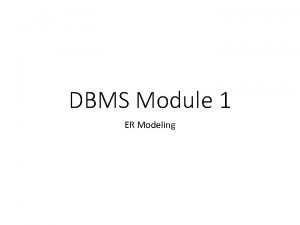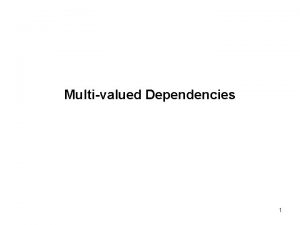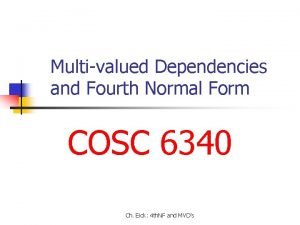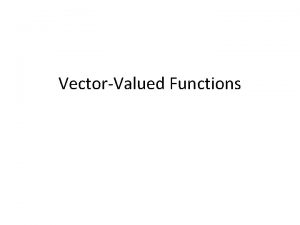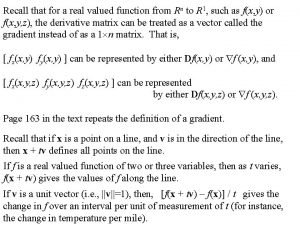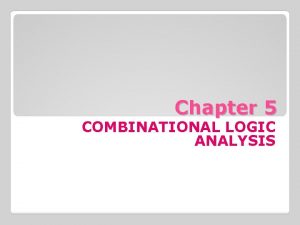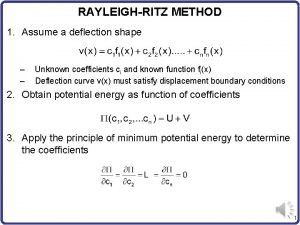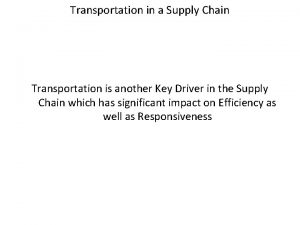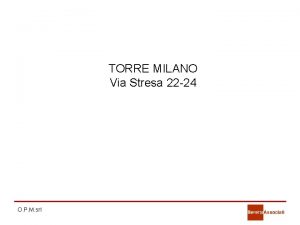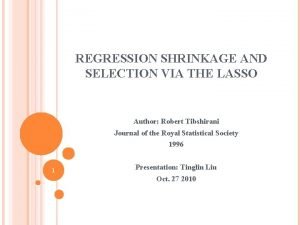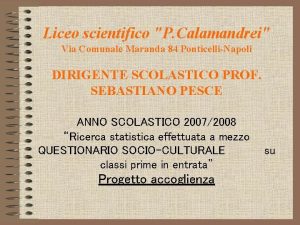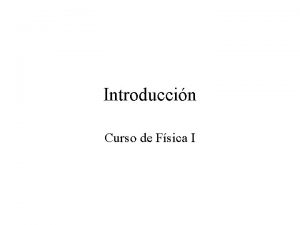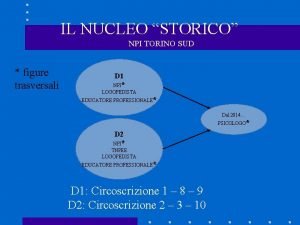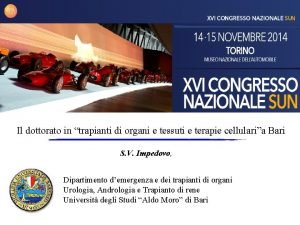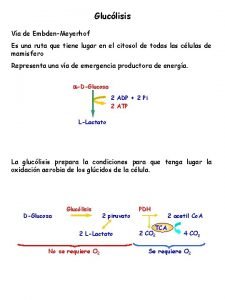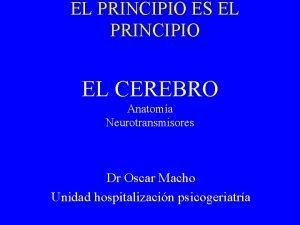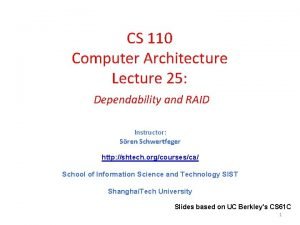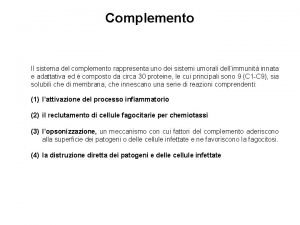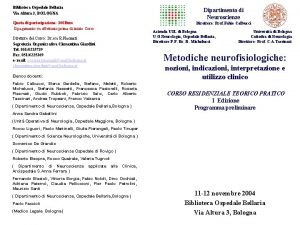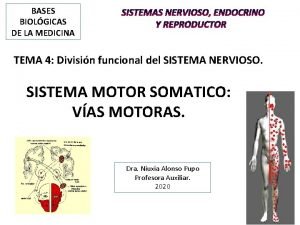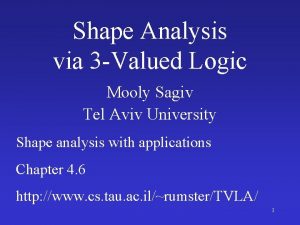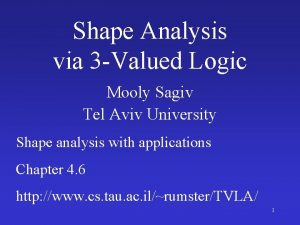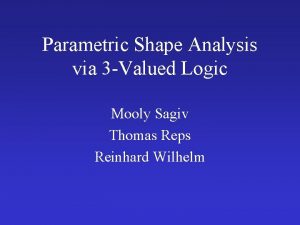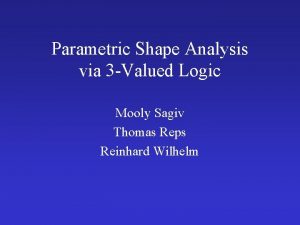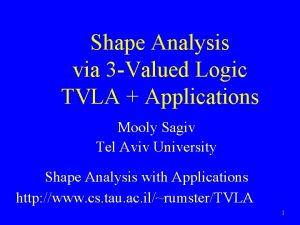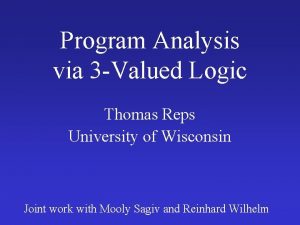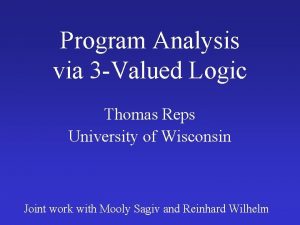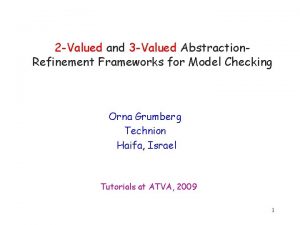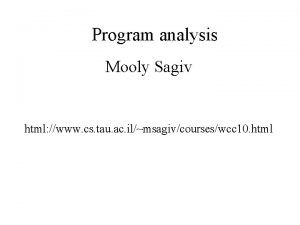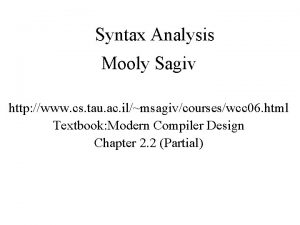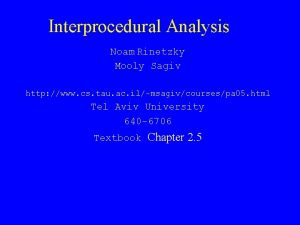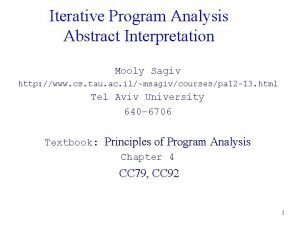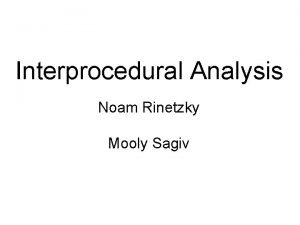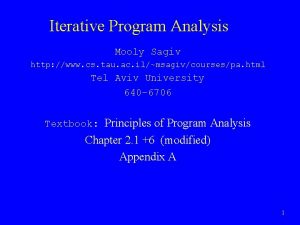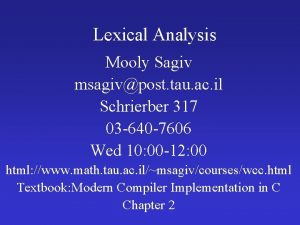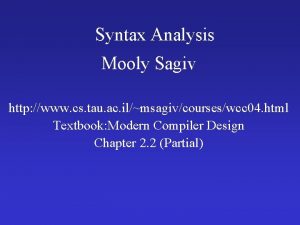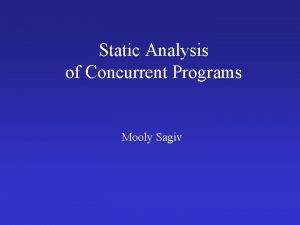Shape Analysis via 3 Valued Logic Mooly Sagiv

































![Boolean Connectives [Kleene] Boolean Connectives [Kleene]](https://slidetodoc.com/presentation_image_h/b5ee954e55a56cc21977a492d87ff7cd/image-34.jpg)







![Challenges: Heap & Concurrency [Yahav POPL’ 01] • Concurrency with the heap is evil… Challenges: Heap & Concurrency [Yahav POPL’ 01] • Concurrency with the heap is evil…](https://slidetodoc.com/presentation_image_h/b5ee954e55a56cc21977a492d87ff7cd/image-42.jpg)
![Configurations – Example held_by at[l_1] rval[my. Lock] blocked at[l_1] rval[my. Lock] at[l_C] rval[my. Lock] Configurations – Example held_by at[l_1] rval[my. Lock] blocked at[l_1] rval[my. Lock] at[l_C] rval[my. Lock]](https://slidetodoc.com/presentation_image_h/b5ee954e55a56cc21977a492d87ff7cd/image-43.jpg)
![Concrete Configuration held_by at[l_1] rval[my. Lock] blocked at[l_C] rval[my. Lock] at[l_1] at[l_0] rval[my. Lock] Concrete Configuration held_by at[l_1] rval[my. Lock] blocked at[l_C] rval[my. Lock] at[l_1] at[l_0] rval[my. Lock]](https://slidetodoc.com/presentation_image_h/b5ee954e55a56cc21977a492d87ff7cd/image-44.jpg)
![Abstract Configuration blocked at[l_1] rval[my. Lock] held_by at[l_C] rval[my. Lock] at[l_0] Abstract Configuration blocked at[l_1] rval[my. Lock] held_by at[l_C] rval[my. Lock] at[l_0]](https://slidetodoc.com/presentation_image_h/b5ee954e55a56cc21977a492d87ff7cd/image-45.jpg)


![Topics • Embedding • Instrumentation • Abstract Interpretation • [Extensions] Topics • Embedding • Instrumentation • Abstract Interpretation • [Extensions]](https://slidetodoc.com/presentation_image_h/b5ee954e55a56cc21977a492d87ff7cd/image-48.jpg)











![Cyclicity predicate c[x]() = v 1, v 2: x(v 1) n*(v 1, v 2) Cyclicity predicate c[x]() = v 1, v 2: x(v 1) n*(v 1, v 2)](https://slidetodoc.com/presentation_image_h/b5ee954e55a56cc21977a492d87ff7cd/image-60.jpg)
![Cyclicity predicate c[x]() = v 1, v 2: x(v 1) n*(v 1, v 2) Cyclicity predicate c[x]() = v 1, v 2: x(v 1) n*(v 1, v 2)](https://slidetodoc.com/presentation_image_h/b5ee954e55a56cc21977a492d87ff7cd/image-61.jpg)



 = n*(v 1, v 2) x t[n] u Reachability predicate t[n](v 1, v 2) = n*(v 1, v 2) x t[n] u](https://slidetodoc.com/presentation_image_h/b5ee954e55a56cc21977a492d87ff7cd/image-65.jpg)






















![Scaling • Staged analysis • Controlled complexity – More coarse abstractions [Manevich SAS’ 04] Scaling • Staged analysis • Controlled complexity – More coarse abstractions [Manevich SAS’ 04]](https://slidetodoc.com/presentation_image_h/b5ee954e55a56cc21977a492d87ff7cd/image-88.jpg)
![Local heaps [Rinetzky, POPL’ 05] x x y call p(x); y g g t Local heaps [Rinetzky, POPL’ 05] x x y call p(x); y g g t](https://slidetodoc.com/presentation_image_h/b5ee954e55a56cc21977a492d87ff7cd/image-89.jpg)




- Slides: 93

Shape Analysis via 3 -Valued Logic Mooly Sagiv Tel Aviv University http: //www. cs. tau. ac. il/~msagiv/toplas 02. ps www. cs. tau. ac. il/~tvla

Topics • A new abstract domain for static analysis • Abstract dynamically allocated memory • TVLA: A system for generating abstract interpreters • Applications

Motivation • Dynamically allocated storage and pointers are essential programming tools – Object oriented – Modularity – Data structure • But – Error prone – Inefficient • Static analysis can be very useful here

A Pathological C Program a = malloc(…) ; b = a; free (a); c = malloc (…); if (b == c) printf(“unexpected equality”);

Dereference of NULL pointers typedef struct element { bool search(int value, Elements *c) { int value; Elements *elem; struct element *next; for (elem = c; } Elements c != NULL; elem = elem->next; ) if (elem->val == value) return TRUE; return FALSE

Dereference of NULL pointers typedef struct element { bool search(int value, Elements *c) { int value; Elements *elem; struct element *next; for (elem = c; } Elements c != NULL; potential null de-reference elem = elem->next; ) if (elem->val == value) return TRUE; return FALSE

Memory leakage typedef struct element { int value; struct element *next; } Elements* reverse(Elements *c) { Elements *h, *g; h = NULL; while (c!= NULL) { g = c->next; h = c; c->next = h; c = g; } return h;

Memory leakage typedef struct element { int value; struct element *next; } Elements leakage of address pointed-by h Elements* reverse(Elements *c) { Elements *h, *g; h = NULL; while (c!= NULL) { g = c->next; h = c; c->next = h; c = g; } return h;

Memory leakage typedef struct element { int value; struct element *next; } Elements ✔ No memory leaks Elements* reverse(Elements *c) { Elements *h, *g; h = NULL; while (c!= NULL) { g = c->next; h = c; c->next = h; c = g; } return h;

Example: List Creation typedef struct node { int val; struct node *next; } *List; List create (…) { List x, t; x = NULL; while (…) do { t = malloc(); t next=x; x = t ; } return x; } ✔ No null dereferences ✔ No memory leaks ✔ Returns acyclic list

Example: Collecting Interpretation x = NULL empty F T t =malloc(. . ); t n t t x x x n t t x t next=x; t x n t t x x=t return x t x x n n x n t t t x n n

Example: Abstract Interpretation x = NULL empty F T t =malloc(. . ); t n t t x x n x t next=x; t t t return x t x n n t t x n x x n n x x=t n t x n n x t t n t n x n n

Challenge 1 - Memory Allocation • The number of allocated objects/threads is not known • Concrete state space is infinite • How to guarantee termination?

Challenge 2 - Destructive Updates • The program manipulates states using destructive updates – e next = t • Hard to define concrete interpretation • Harder to define abstract interpretation

Challenge 2 - Destructive Update x n p x y n x p n p y y next = NULL x n p x y x p p y Unsound

Challenge 2 - Destructive Update x n p y y next = NULL x n y Imprecise p

Challenge 3 – Re-establishing Data Structure Invariants • Data-structure invariants typically only hold at the beginning and end of ADT operations • Need to verify that data-structure invariants are re-established

Challenge 3 – Re-establishing Data Structure Invariants rotate(List first, List last) { if ( first != NULL) { last next = first; first = first next; last = last next; last next = NULL; } first n n n last n first n n n last first n } n n n last first n n n

Plan • Concrete interpretation • Canonical abstraction • Abstract interpretation using canonical abstraction • The TVLA system

Traditional Heap Interpretation • States = Two level stores – Env: Var Values – fields: Loc Values – Values=Loc Atoms • Example – Env = [x 30, p 79] – next = [30 40, 40 50, 50 79, 79 90] – val = [30 1, 40 2, 50 3, 79 4, 90 5] x 30 1 40 40 2 50 3 p 90 79 50 79 4 90 5 0

Predicate Logic • Vocabulary – A finite set of predicate symbols P each with a fixed arity • Logical Structures S provide meaning for predicates – A set of individuals (nodes) U – p. S: (US)k {0, 1} • FOTC over TC, express logical structure properties

Representing Stores as Logical Structures • • Locations Individuals Program variables Unary predicates Fields Binary predicates Example – U = {u 1, u 2, u 3, u 4, u 5} – x = {u 1}, p = {u 3} – n = {<u 1, u 2>, <u 2, u 3>, <u 3, u 4>, <u 4, u 5>} x u 1 n u 2 p n u 3 n u 4 n u 5

Formal Semantics of First Order Formulae • • For a structure S=<US, p. S> Formulae with LVar free variables Assignment z: LVar US S(z): {0, 1} 1 S(z)=1 0 S(z)=0 p (v 1, v 2, …, vk) S(z)=p. S (z(v 1), z(v 2), …, z(vk))

Formal Semantics of First Order Formulae • • For a structure S=<US, p. S> Formulae with LVar free variables Assignment z: LVar US S(z): {0, 1} 1 2 S(z)=max ( 1 S(z), 2 S(z)) 1 2 S(z)=min ( 1 S(z), 2 S(z)) 1 S(z)=1 - 1 S(z) v: 1 S(z)=max { 1 S(z[v u]) : u US}

Formal Semantics of Transitive Closure • • For a structure S=<US, p. S> Formulae with LVar free variables Assignment z: LVar US S(z): {0, 1} p*(v 1, v 2) S(z) = max {u 1, . . . , uk U, Z(v 1)=u 1, Z(v 2)=uk} min{1 i < k} p. S(ui, ui+1)

Concrete Interpretation Rules Statement Update formula x =NULL x’(v)= 0 x= malloc() x’(v) = Is. New(v) x=y x’(v)= y(v) x=y next x’(v)= w: y(w) n(w, v) x next=y n’(v, w) = ( x(v) n(v, w)) (x(v) y(w))

Invariants • No memory leaks v: {x PVar} w: x(w) n*(w, v) • Acyclic list(x) v, w: x(v) n*(v, w) n+(w, v) • Reverse (x) v, w, r: x(v) n*(v, w) n(w, r) n’(r, w)

Why use logical structures? • Naturally model pointers and dynamic allocation • No a priori bound on number of locations • Use formulas to express semantics • Indirect store updates using quantifiers • Can model other features – Concurrency – Abstract fields

Why use logical structures? • Behaves well under abstraction • Enables automatic construction of abstract interpreters from concrete interpretation rules (TVLA)

Collecting Interpretation • The set of reachable logical structures in every program point • Statements operate on sets of logical structures • Cannot be directly computed for programs with unbounded store and loops x = NULL; while (…) do { t = malloc(); empty x u 1 t } x t n u 2 t t next=x; x=t u 1 x u 1 n u 2 n … n un

Plan • Concrete interpretation • Canonical abstraction • TVLA

Canonical Abstraction • Convert logical structures of unbounded size into bounded size • Guarantees that number of logical structures in every program is finite • Every first-order formula can be conservatively interpreted

Kleene Three-Valued Logic • 1 : True • 0: False • 1/2: Unknown • A join semi-lattice: 0 1 = 1/2 Information order Logical order
![Boolean Connectives Kleene Boolean Connectives [Kleene]](https://slidetodoc.com/presentation_image_h/b5ee954e55a56cc21977a492d87ff7cd/image-34.jpg)
Boolean Connectives [Kleene]

3 -Valued Logical Structures • A set of individuals (nodes) U • Predicate meaning – p. S: (US)k {0, 1, 1/2}

Canonical Abstraction • Partition the individuals into equivalence classes based on the values of their unary predicates – Every individual is mapped into its equivalence class • Collapse predicates via – p. S (u’ 1, . . . , u’k) = {p. B (u 1, . . . , uk) | f(u 1)=u’ 1, . . . , f(u’k)=u’k) } • At most 2 A abstract individuals

Canonical Abstraction x = NULL; while (…) do { x t = malloc(); u 1 n u 2 n t t next=x; x=t } x t u 1 n u 2, 3 n u 3

Canonical Abstraction x = NULL; while (…) do { x t = malloc(); u 1 n n u 2 t t next=x; n x=t } x t u 1 n u 2, 3 n u 3

Canonical Abstraction and Equality • Summary nodes may represent more than one element • (In)equality need not be preserved under abstraction • Explicitly record equality • Summary nodes are nodes with eq(u, u)=1/2

Canonical Abstraction and Equality eq x = NULL; while (…) do { eq x t = malloc(); u 1 n u 2 t t next=x; eq eq x=t } eq eq x t u 1 eq n n u 3 eq eq u 2, 3 n eq

Canonical Abstraction x = NULL; while (…) do { x t = malloc(); u 1 n u 2 n t t next=x; x=t } x t u 1 n u 2, 3 n u 3
![Challenges Heap Concurrency Yahav POPL 01 Concurrency with the heap is evil Challenges: Heap & Concurrency [Yahav POPL’ 01] • Concurrency with the heap is evil…](https://slidetodoc.com/presentation_image_h/b5ee954e55a56cc21977a492d87ff7cd/image-42.jpg)
Challenges: Heap & Concurrency [Yahav POPL’ 01] • Concurrency with the heap is evil… • Java threads are just heap allocated objects • Data and control are strongly related – Thread-scheduling info may require understanding of heap structure (e. g. , scheduling queue) – Heap analysis requires information about thread scheduling Thread t 1 = new Thread(); Thread t 2 = new Thread(); … t = t 1; … t. start();
![Configurations Example heldby atl1 rvalmy Lock blocked atl1 rvalmy Lock atlC rvalmy Lock Configurations – Example held_by at[l_1] rval[my. Lock] blocked at[l_1] rval[my. Lock] at[l_C] rval[my. Lock]](https://slidetodoc.com/presentation_image_h/b5ee954e55a56cc21977a492d87ff7cd/image-43.jpg)
Configurations – Example held_by at[l_1] rval[my. Lock] blocked at[l_1] rval[my. Lock] at[l_C] rval[my. Lock] at[l_0] l_0: while (true) { l_1: synchronized(my. Lock) { l_C: // critical actions l_2: } l_3: }
![Concrete Configuration heldby atl1 rvalmy Lock blocked atlC rvalmy Lock atl1 atl0 rvalmy Lock Concrete Configuration held_by at[l_1] rval[my. Lock] blocked at[l_C] rval[my. Lock] at[l_1] at[l_0] rval[my. Lock]](https://slidetodoc.com/presentation_image_h/b5ee954e55a56cc21977a492d87ff7cd/image-44.jpg)
Concrete Configuration held_by at[l_1] rval[my. Lock] blocked at[l_C] rval[my. Lock] at[l_1] at[l_0] rval[my. Lock] at[l_0]
![Abstract Configuration blocked atl1 rvalmy Lock heldby atlC rvalmy Lock atl0 Abstract Configuration blocked at[l_1] rval[my. Lock] held_by at[l_C] rval[my. Lock] at[l_0]](https://slidetodoc.com/presentation_image_h/b5ee954e55a56cc21977a492d87ff7cd/image-45.jpg)
Abstract Configuration blocked at[l_1] rval[my. Lock] held_by at[l_C] rval[my. Lock] at[l_0]

Examples Verified Program Property two. Lock Q No interference No memory leaks Partial correctness Producer/consumer No interference No memory leaks Counter increasing Apprentice Challenge Dining philosophers with resource ordering Mutex Web Server Absence of deadlock Mutual exclusion No interference

Summary • Canonical abstraction guarantees finite number of structures • The concrete location of an object plays no significance • But what is the significance of 3 -valued logic?
![Topics Embedding Instrumentation Abstract Interpretation Extensions Topics • Embedding • Instrumentation • Abstract Interpretation • [Extensions]](https://slidetodoc.com/presentation_image_h/b5ee954e55a56cc21977a492d87ff7cd/image-48.jpg)
Topics • Embedding • Instrumentation • Abstract Interpretation • [Extensions]

Embedding x x u 1 u 2 x u 456 u 123 u 12 u 4 u 34 u 56 u 6

Embedding • B f S • onto function f • p. B(u 1, . . , uk) p. S (f(u 1), . . . , f(uk)) • S is a tight embedding of B with respect to f if: • p. S(u#1, . . , u#k) = {p. B (u 1. . . , uk) | f(u 1)=u#1, . . . , f(uk)=u#k} • Canonical Abstraction is a tight embedding

Embedding (cont) • S 1 f S 2 every concrete state represented by S 1 is also represented by S 2 • The set of nodes in S 1 and S 2 may be different – No meaning for node names (abstract locations) • (S#)= {S : 2 -valued structure S, S f S#}

Embedding Theorem • Assume B f S, p. B(u 1, . . , uk) p. S (f(u 1), . . . , f(uk)) • Then every formula is preserved: – If = 1 in S, then = 1 in B – If = 0 in S, then = 0 in B – If = 1/2 in S, then could be 0 or 1 in B

Embedding Theorem • For every formula is preserved: – If = 1 in S, then = 1 for all B (S) – If = 0 in S, then = 0 for all B (S) – If = 1/2 in S, then could be 0 or 1 in (S)

Challenge 2 - Destructive Update x n p y y next = NULL n’(v, w) = y(v) n(v, w) x p y Sound

Challenge 2 - Destructive Update x n p y y next = NULL n’(v, w) = y(v) n(v, w) x p y Sound

Embedding Theorem x u 1 t n u 2, 3 n v: x(v) 1=Yes v: x(v) t(v) 1=Yes v: x(v) y(v) 0=No v, w: x(v) n(v, w) ½=Maybe v, w: x(v) n(v, w) v, w: x(v) n*(v, w) n+(w, w) 0=No 1/2=Maybe

Summary • The embedding theorem eliminates the need for proving near commutavity • Guarantees soundness • Applied to arbitrary logics • But can be imprecise

Limitations • Information on summary nodes is lost • Leads to useless verification

Increasing Precision • User (Programming Language) supplied global invariants – Naturally expressed in FOTC • Record extra information in the concrete interpretation – Tune the abstraction – Refine concretization
![Cyclicity predicate cx v 1 v 2 xv 1 nv 1 v 2 Cyclicity predicate c[x]() = v 1, v 2: x(v 1) n*(v 1, v 2)](https://slidetodoc.com/presentation_image_h/b5ee954e55a56cc21977a492d87ff7cd/image-60.jpg)
Cyclicity predicate c[x]() = v 1, v 2: x(v 1) n*(v 1, v 2) n+(v 2, v 2) c[x]()=0 u 1 x t c[x]()=0 x t n u 2 u 1 n n … n u 2. . n n un
![Cyclicity predicate cx v 1 v 2 xv 1 nv 1 v 2 Cyclicity predicate c[x]() = v 1, v 2: x(v 1) n*(v 1, v 2)](https://slidetodoc.com/presentation_image_h/b5ee954e55a56cc21977a492d87ff7cd/image-61.jpg)
Cyclicity predicate c[x]() = v 1, v 2: x(v 1) n*(v 1, v 2) n+(v 2, v 2) n c[x]()=1 u 1 n x u 2 n t c[x]()=1 x t u 1 n … n u 2. . n n un

Heap Sharing predicate is(v) = v 1, v 2: n(v 1, v) n(v 2, v) v 1 v 2 is(v)=0 u 1 x t x is(v)=0 n u 2 u 1 t is(v)=0 n n is(v)=0 … n un u 2. . n n is(v)=0

Heap Sharing predicate is(v) = v 1, v 2: n(v 1, v) n(v 2, v) v 1 v 2 is(v)=0 u 1 n x is(v)=1 u 2 n t is(v)=0 … n un n n x u 1 n u 2 n t is(v)=0 u 3. . n n is(v)=1 is(v)=0

Concrete Interpretation Rules Statement Update formula x =NULL x’(v)= 0 x= malloc() x’(v) = Is. New(v) x=y x’(v)= y(v) x=y next x’(v)= w: y(w) n(w, v) x next=NULL n’(v, w) = x(v) n(v, w) is’(v) = is(v) v 1, v 2: n(v 1, v) n(v 2, v) x(v 1) x(v 2) eq(v 1, v 2)
 = n*(v 1, v 2) x t[n] u](https://slidetodoc.com/presentation_image_h/b5ee954e55a56cc21977a492d87ff7cd/image-65.jpg)
Reachability predicate t[n](v 1, v 2) = n*(v 1, v 2) x t[n] u 1 u 2 t n t[n] n un n t[n] x t u 1 t[n] n u 2. . n n t[n]

Additional Instrumentation predicates • • • reachable-from-variable-x(v) cfb(v) = v 1: f(v, v 1) b(v 1, v) tree(v) dag(v) in. Order(v) = v 1: n(v, v 1) dle(v, v 1) • Weakest Precondition [Ramalingam PLDI 02]

Instrumentation (Summary) • Refines the abstraction is(v) = v 1, v 2: n(v 1, v) n(v 2, v) v 1 v 2 • Adds global invariants is(v) v 1, v 2: n(v 1, v) n(v 2, v) v 1 v 2 (S#)={S : S , S f S#} • But requires update-formulas (generated automatically in TVLA 2

Plan • Embedding Theorem • Instrumentation • Abstract interpretation using canonical abstraction • TVLA

Best Conservative Interpretation (CC 79) Concrete Representation Concretization Abstract Interpretation Collecting Interpretation st # st c Concrete Representation Abstraction Abstract Representation

Best Transformer (x = x n) x y . . . x y inverse embedding Evaluate update formulas x y y x . . . x canonic abstraction y y x

“Focus”- Based Transformer (x = x n) x y . . . x y inverse embedding Evaluate update formulas x y y x . . . x canonic abstraction y y x

“Focus”-Based Transformer (x = x n) x y Focus(x n) “Partial ” x y Evaluate update Formulas (Kleene) x x y y x canonic y y x

Semantic Reduction • Improve the precision by recovering properties of the program semantics • A Galois connection (L 1, , , L 2) • An operation op: L 2 is a semantic reduction – l L 2 op(l) l – (op(l)) = (l) • Can be applied before and after basic operations L 1 L 2 l op

Three Valued Logic Analysis (TVLA) T. Lev-Ami & R. Manevich • Input (FOTC) – – Concrete interpretation rules Definition of instrumentation predicates Definition of safety properties First Order Transition System (TVP) • Output – Warnings (text) – The 3 -valued structure at every node (invariants)

Null Dereferences typedef struct element { int value; struct element n; } Element Demo bool search( int value, Element x) { Element c = x while ( x != NULL ) { if (c val == value) return TRUE; c = c n; } 40 return FALSE; }

TVLA inputs TVP - Three Valued Program – Predicate declaration – Action definitions SOS – Control flow graph Program independent • TVS - Three Valued Structure Demo

Challenge 1 • Write a C procedure on which TVLA reports false null dereference

Proving Correctness of Sorting Implementations (Lev-Ami, Reps, S, Wilhelm ISSTA 2000) • Partial correctness – The elements are sorted – The list is a permutation of the original list • Termination – At every loop iterations the set of elements reachable from the head is decreased

Example: Insert. Sort typedef struct list_cell { int data; struct list_cell *n; } *List; pred. tvp actions. tvp Run Demo List Insert. Sort(List x) { List r, pr, rn, l, pl; r = x; pr = NULL; while (r != NULL) { l = x; rn = r n; pl = NULL; while (l != r) { if (l data > r data) { pr n = rn; r n = l; if (pl = = NULL) x = r; else pl n = r; r = pr; break; } pl = l; l = l n; } pr = r; r = rn; } return x; }

Example: Insert. Sort typedef struct list_cell { int data; struct list_cell *n; } *List; Run Demo List Insert. Sort(List x) { if (x == NULL) return NULL pr = x; r = x->n; while (r != NULL) { pl = x; rn = r->n; l = x->n; while (l != r) { pr->n = rn ; r->n = l; pl->n = r; r = pr; break; } pl = l; l = l->n; } pr = r; r = rn; } 14

Example: Reverse typedef struct list_cell { int data; struct list_cell *n; } *List; Run Demo List reverse (List x) { List y, t; y = NULL; while (x != NULL) { t = y; y = x; x = x next; y next = t; } return y; }

Challenge • Write a sorting C procedure on which TVLA fails to prove sortedness or permutation

Example: Mark and Sweep void Mark(Node root) { if (root != NULL) { pending = pending {root} marked = while (pending ) { x = Select. And. Remove(pending) marked = marked {x} t = x left if (t NULL) if (t marked) pending = pending {t} t = x right if (t NULL) if (t marked) pending = pending {t} } } assert(marked = = Reachset(root)) } void Sweep() { unexplored = Universe collected = while (unexplored ) { x = Select. And. Remove(unexplored) if (x marked) collected = collected {x} } assert(collected = = Universe – Reachset(root) ) } pred. tvp Run Demo

Challenge 2 • Use TVLA to show termination of mark. And. Sweep

Verification of Safety Properties (PLDI’ 02, 04) The Canvas Project (with IBM Watson) (Component Annotation, Verification and Stuff) Component a library with cleanly encapsulated state Lightweight Specification §"correct usage" rules a client must follow §"call open() before read()" Client a program that uses the library Certification does the client program satisfy the lightweight specification?

Prototype Implementation • Applied to several example programs – Up to 5000 lines of Java • Used to verify – Absence of concurrent modification exception – JDBC API conformance – IOStreams API conformance

![Scaling Staged analysis Controlled complexity More coarse abstractions Manevich SAS 04 Scaling • Staged analysis • Controlled complexity – More coarse abstractions [Manevich SAS’ 04]](https://slidetodoc.com/presentation_image_h/b5ee954e55a56cc21977a492d87ff7cd/image-88.jpg)
Scaling • Staged analysis • Controlled complexity – More coarse abstractions [Manevich SAS’ 04] • Handle libraries – Use procedure specifications [Yorsh, TACAS’ 04] – Decision procedures for linked data structures [Immerman, CAV’ 04, Lev-Ami, CADE’ 05] • Handling procedures – Compute procedure summaries [Jeannet, SAS’ 04] – Local heaps [Rinetzky, POPL’ 05]
![Local heaps Rinetzky POPL 05 x x y call px y g g t Local heaps [Rinetzky, POPL’ 05] x x y call p(x); y g g t](https://slidetodoc.com/presentation_image_h/b5ee954e55a56cc21977a492d87ff7cd/image-89.jpg)
Local heaps [Rinetzky, POPL’ 05] x x y call p(x); y g g t t

Why is Heap Analysis Difficult? • Destructive updating through pointers – p next = q – Produces complicated aliasing relationships – Track aliasing on 3 -valued structures • Dynamic storage allocation – No bound on the size of run-time data structures – Canonical abstraction finite-sized 3 -valued structures • Data-structure invariants typically only hold at the beginning and end of operations – Need to verify that data-structure invariants are reestablished – Query the 3 -valued structures that arise at the exit

Summary • Canonical abstraction is powerful – Intuitive – Adapts to the property of interest • Used to verify interesting program properties – Very few false alarms • But scaling is an issue

Summary • Effective Abstract Interpretation – Always terminates – Precise enough – But still expensive • Can model – Heap – Unbounded arrays – Concurrency • More instrumentation can mean more efficient • But canonic abstraction is limited – Correlation between list lengths – Arithmetic – Partial heaps

Summary • The embedding theorem eliminates the need for proving near commutavity • Guarantees soundness • Applied to arbitrary logics • But can be imprecise
 Mooly sagiv
Mooly sagiv Single valued and multi valued attributes
Single valued and multi valued attributes Decimoquinta estacion del via crucis
Decimoquinta estacion del via crucis Via negativa
Via negativa Estaciones vialucis
Estaciones vialucis Motoneurona superior e inferior anatomia
Motoneurona superior e inferior anatomia Via erudita e via popular
Via erudita e via popular Socially valued resources
Socially valued resources Multivalued dependencies
Multivalued dependencies Multivalued dependency definition
Multivalued dependency definition Communication and employability skills for it
Communication and employability skills for it When you group subcategories within broader concepts
When you group subcategories within broader concepts Which of these are valued as a special zero-growth case
Which of these are valued as a special zero-growth case Find the domain of the vector-valued function
Find the domain of the vector-valued function Real valued function
Real valued function First order logic vs propositional logic
First order logic vs propositional logic First order logic vs propositional logic
First order logic vs propositional logic First order logic vs propositional logic
First order logic vs propositional logic Combinational logic circuit vs sequential
Combinational logic circuit vs sequential Cryptarithmetic problem logic+logic=prolog
Cryptarithmetic problem logic+logic=prolog Software project wbs example
Software project wbs example Majority circuit
Majority circuit Combinational logic sequential logic 차이
Combinational logic sequential logic 차이 Combinational logic sequential logic
Combinational logic sequential logic Aerodynamic shape vs aerofoil shape
Aerodynamic shape vs aerofoil shape Shape matching and object recognition using shape contexts
Shape matching and object recognition using shape contexts Bolongie
Bolongie Combinational logic analysis
Combinational logic analysis What is aoi logic
What is aoi logic Rayleigh ritz method cantilever beam example
Rayleigh ritz method cantilever beam example Asea source
Asea source Villa doria dangri
Villa doria dangri Sistema anterolateral y dorsal lemnisco
Sistema anterolateral y dorsal lemnisco Via topica
Via topica Via aerea supraglotica
Via aerea supraglotica Tapon homeostatico
Tapon homeostatico Bilirrubina valores normales
Bilirrubina valores normales Via de la bilirrubina
Via de la bilirrubina Vía mesolimbica
Vía mesolimbica Milk runs supply chain
Milk runs supply chain Torre milano via stresa
Torre milano via stresa Receptor sensorial
Receptor sensorial Paraplegia spastica ereditaria
Paraplegia spastica ereditaria Via castelgomberto 73 torino
Via castelgomberto 73 torino Vias aereas superiores
Vias aereas superiores Via classica del complemento
Via classica del complemento Reflejos primitivos
Reflejos primitivos Do que miranda amiga de via chamava august
Do que miranda amiga de via chamava august Residenze universitarie a torino
Residenze universitarie a torino Via eminentia
Via eminentia Regression shrinkage and selection via the lasso.
Regression shrinkage and selection via the lasso. Vía mesolimbica
Vía mesolimbica Niveles normales de bilirrubina en neonatos
Niveles normales de bilirrubina en neonatos Cono axonico
Cono axonico Odonto system 2 via
Odonto system 2 via Acetoacetic ester synthesis mechanism
Acetoacetic ester synthesis mechanism Nuclei della base
Nuclei della base Via comunale maranda napoli
Via comunale maranda napoli Via natale carta palermo
Via natale carta palermo Via pettinati 46 padova
Via pettinati 46 padova Via-direct trading
Via-direct trading Esteban garcia la casa de los espiritus
Esteban garcia la casa de los espiritus Katetertyper
Katetertyper Ic via roma spirito santo
Ic via roma spirito santo Diametro de la via lactea en notacion cientifica
Diametro de la via lactea en notacion cientifica Fenitoina via de administracion
Fenitoina via de administracion Via acustica
Via acustica Asl via alassio 36 torino
Asl via alassio 36 torino Via alternativa complemento
Via alternativa complemento Idrocentro santena
Idrocentro santena Ics madre teresa di calcutta
Ics madre teresa di calcutta Office interface vs industrial interface
Office interface vs industrial interface Cefotaxima via oral
Cefotaxima via oral Hera modena via razzaboni
Hera modena via razzaboni Via de embden meyerhof
Via de embden meyerhof Training gaussian mixture models at scale via coresets
Training gaussian mixture models at scale via coresets Via indiretta gangli della base
Via indiretta gangli della base Engångsunderlägg blöjbyte
Engångsunderlägg blöjbyte Vía paleoespinotalámica
Vía paleoespinotalámica Via lucis corto
Via lucis corto Movimiento de los astros
Movimiento de los astros Via nigroestriada
Via nigroestriada Spazio eventi via tortona
Spazio eventi via tortona Data exposure via rest api
Data exposure via rest api Dependability via redundancy
Dependability via redundancy Via topica
Via topica Via voice ibm
Via voice ibm Sistema del complemento
Sistema del complemento Collaborating via social networks and groupware
Collaborating via social networks and groupware Single window china
Single window china Tipo de galaxia
Tipo de galaxia Via altura 3 bologna
Via altura 3 bologna Decusacion piramidal
Decusacion piramidal Vie parenterali
Vie parenterali

